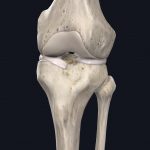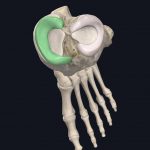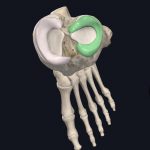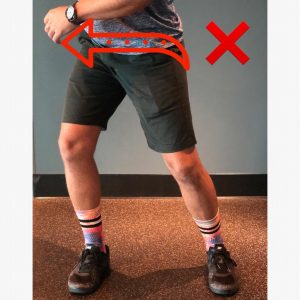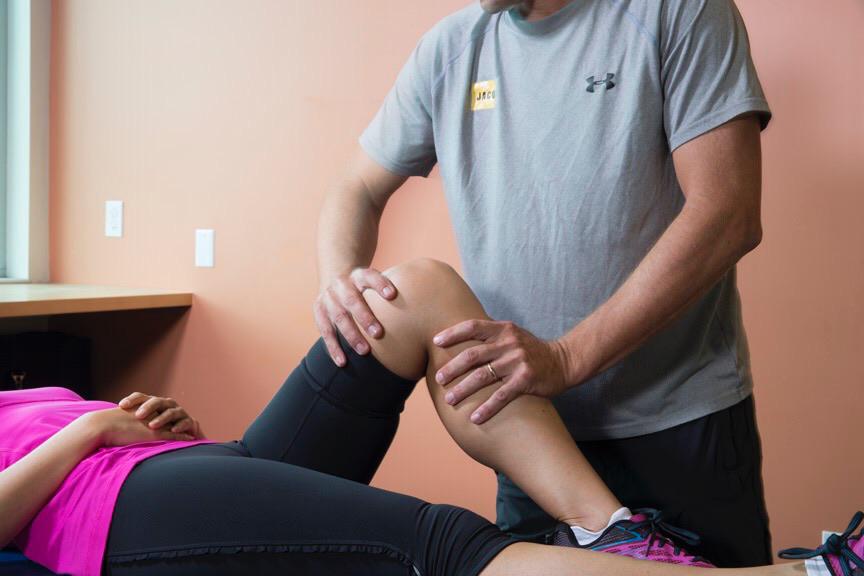
A meniscus tear can sound like a major issue. If your doctor suspects a tear, or if the tear has been confirmed by an MRI, you’re probably wondering what’s next.
Good news! Not all meniscus injuries require surgery. It’s possible to avoid surgery with conservative care, like physical therapy.
Unless surgery is strongly advised by your doctor, you should seek conservative treatment. Reach out to JACO Rehab and book an appointment. We can help!
What’s a Meniscus?
You have two menisci in your knee: the medial and lateral meniscus. Both are circular cartilage structures in the knee joint. They have a flexible and fibrous structure, which serves as an excellent shock absorption system when walking, running, and jumping.
Menisci also help the joint “fit” well by improving how the femur glides on the tibia when you bend or straighten your knee. They even have their own lubrication system which delivers nutrients to the joint. (2)
- Front View of Knee
- Medial Meniscus in Knee (highlighted)
- Lateral Meniscus in Knee (highlighted)
Images courtesy of Complete Anatomy
If you reference the picture above, you’ll see that the medial meniscus is larger than the lateral one. The medial meniscus is a major stabilizer in the joint, but it’s also torn most often.
Unfortunately, menisci have mostly poor blood supply. The outside rim of the meniscus is the most vascularized area. Poor blood supply means less self-healing potential, particularly large tears in less vascularized areas. (1)
How Do I Injure a Meniscus?
Stress is placed on the menisci when excessive weight or pressure goes through them.
A meniscus is usually torn with compression and twisting. Common scenarios including cutting during sport or stepping in a hole that twists the leg unexpectedly or excessively.
Meniscus injuries have similar mechanisms of injury as ACL injuries. Some people can tear both.
- Compressing and Twisting the Knee
How Do I Know If I’ve Torn My Meniscus?
A meniscus tear is not always obvious. You may have a tear if your symptoms include:
- Swelling
- Warmth
- Lacking full mobility
- Painful walking, especially pivoting or twisting
- “Giving out” or “locking”
There are many injury presentations that come and go. One day the knee is painful and limiting, then the next day it’s totally fine.
Some tears show tiny amounts of swelling with occasional pain, but nothing too limiting.
There is variation in the injury because each tear is unique. They vary in:
- Location
- Size
- Depth
- Shape
The only way to confirm a tear’s characteristics is with an MRI. However, you don’t always need an MRI to treat a tear. Many cases are addressed successfully in physical therapy.
Types of Meniscus Tears
There are five main shapes of meniscus tears. Keep in mind that this list is generalized. Tears vary in presentation depending on their size, depth, and location. (4)
Vertical Longitudinal Tears
Longitudinal tears run between the fibers of the meniscus, so they aren’t always painful or limiting. These are common on the medial meniscus. Complete longitudinal tears can result in a “bucket handle tear” which can be symptomatic and may need surgical care.
Vertical Radial Tears
Radial tears run across the fibers of the meniscus and affect shock absorption. They are common on the lateral meniscus. They may need surgical care, although they can be hard to repair.
Horizontal Tears
Horizontal tears are like vertical longitudinal tears because they run between the fibers. These tears split the meniscus into upper and lower portions, making it easy to “flip” up and cause locking or catching. Otherwise, it can remain generally asymptomatic. This tear can be treated conservatively, but if catching becomes more frequent, it can be a falls risk. In those cases, surgery may be warranted.
Oblique Tears
Oblique tears are usually symptomatic and cause functional limitation. The tear usually causes painful catching in certain positions, particularly during knee bending. It may require surgery.
Complex/Degenerative Tears
Degenerative tears occur with age and wear. They usually consist of fraying and small accumulated tears. Most people develop degeneration at some level, but it isn’t always symptomatic.
Degenerative tears are commonly and successfully addressed in physical therapy clinics. In fact, it’s considered the first line of treatment. (3) Advanced cases may require a joint replacement.
Even tears that could be treated conservatively could have persistent symptoms. If your mobility and function hasn’t made improvements over time, you may need further intervention.
Physical Therapy for a Meniscus Tear
Meniscus tears with mild symptoms can be addressed in the clinic. The types of tears that can be managed conservatively are degenerative, longitudinal, and horizontal tears.
The main priority is restoring range of motion. Once you have full mobility in the knee, your physical therapist will walk you through exercises to reinforce the new mobility.
The next priority is strengthening the joint’s protective musculature. That includes (but is not limited to) the quads, core, and glutes.
Your therapist may evaluate other associated joints like your hip and ankle. Deficits in other joints could place unnecessary demands on the knee. The goal is to offload the injured meniscus!
You’ll slowly progress your programming towards functional activities and goals like navigating stairs, walking on uneven ground, and pivoting.
What Happens If I Don’t Address My Meniscus Tear?
If you allow your meniscus tear to go untreated, symptoms may worsen or improve. It depends on the severity of your symptoms and location of the tear.
If your symptoms are worsening or unchanging despite conservative care, you may need meniscus surgery to address it.
Persistently symptomatic meniscus injuries could cause early onset of osteoarthritis in the knee. It makes complete sense if you think of what arthritis really is: wear and tear.
It’s always a good idea to get your movement assessed by a physical therapist to determine why your injury occurred in the first place. If your tear is manageable without surgery, your therapist can show you ways to protect the existing tear using muscular support. You’ll also learn how to prevent future injury.
Knee Braces for Meniscus Tears: Good Idea?
Knee bracing with a store-bought product can be a good idea during activity, but you should not depend on the brace for support all the time.
Over-bracing can be a problem. If the brace is providing most of the support, you end up deconditioning the muscles that are supposed to do that job. Spending time outside of the brace is important, and if you can, aim to wean from your brace completely.
Braces are most appropriate after surgeries to protect the joint or to provide additional support that muscles are not ready to provide.
Once you start physical therapy, neuromuscular strength occurs very quickly. You may start noticing changes in your tolerance to squatting, walking and stairs after a few weeks. That is when your therapist may suggest weaning from your brace. He/she can help guide you through in a weaning schedule so that you feel confident moving forward.
Please note: If you have received surgery, your doctor will likely prescribe a specific brace. It is important that you abide by his/her protocol completely. Do not wean from a post-surgical brace without your doctor’s permission. Weaning too early could compromise the surgery. The last thing you want is another surgery.
How to Prevent Meniscus Tears
A meniscus is torn with excessive compression and twisting. The best way to prevent all types of meniscus tears is by controlling those movements.
By training your muscles to absorb force, you can offload the meniscus. Plyometric training is a great way to teach your body how to absorb your landing. If you don’t know where or how to start, ask a physical therapist or trainer about appropriate exercises for you.
Rotational control is rooted at the core and hips. You can combat unnecessary twisting demands at the knee by making sure you can control twisting in other places. Training the glutes, abdominals, and multifidi (in your back) can help you align your leg during movements and displace twisting forces away from the knee. Again, if you’re not sure where to start, ask a physical therapist or a trainer.
You can keep your knee mobile by riding a bike, swimming, or walking. If you’re trying these for the first time, you should start with small time increments then progress as tolerated.
The worst way to prevent meniscus injury is by avoiding movement altogether. Your joints need exposure to movement. Without it, nutrients cannot travel to the surrounding tissue and your muscles will stop protecting your joints.
Reach out
Contact our therapists for an appointment at JACO Rehab. We service most of the island with one-on-one treatment for more than 50 minutes. Start your healing journey today!
Written by Nicole Hernandez, DPT
Sources
1. Bhan K. Meniscal Tears: Current Understanding, Diagnosis, and Management. Cureus. 2020 Jun 13;12(6):e8590. doi: 10.7759/cureus.8590. PMID: 32676231; PMCID: PMC7359983.
2. Fox AJ, Bedi A, Rodeo SA. The basic science of human knee menisci: structure, composition, and function. Sports Health. 2012 Jul;4(4):340-51. doi: 10.1177/1941738111429419. PMID: 23016106; PMCID: PMC3435920.
3. Herrlin SV, Wange PO, Lapidus G, Hållander M, Werner S, Weidenhielm L. Is arthroscopic surgery beneficial in treating non-traumatic, degenerative medial meniscal tears? A five year follow-up. Knee Surg Sports Traumatol Arthrosc. 2013;21:358–364.
4. Mordecai SC, Al-Hadithy N, Ware HE, Gupte CM. Treatment of meniscal tears: An evidence based approach. World J Orthop. 2014 Jul 18;5(3):233-41. doi: 10.5312/wjo.v5.i3.233. PMID: 25035825; PMCID: PMC4095015.
